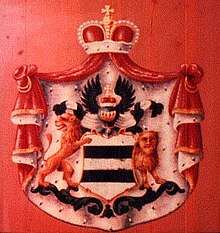| This article does not cite any sources. Please help improve this article by adding citations to reliable sources. Unsourced material may be challenged and removed. Find sources: "Isenburg-Büdingen" – news · newspapers · books · scholar · JSTOR (May 2024) (Learn how and when to remove this message) |

Isenburg-Büdingen was a County of southern Hesse, Germany, located in Büdingen. It was originally a part of the County of Isenburg.
History


There were two different Counties of the same name. The first (1341–1511) was a partition of Isenburg-Cleberg, and was partitioned into Isenburg-Büdingen-Birstein and Isenburg-Ronneburg in 1511. The second (1628–1806) was a partition of Isenburg-Büdingen-Birstein. It was partitioned between itself, Isenburg-Meerholz and Isenburg-Wächtersbach in 1673, and was mediatised to Isenburg in 1806. In 1816 Isenburg was partitioned between the Grand Duchy of Hesse-Darmstadt and the Electorate of Hesse-Kassel.
Count Ernest Casimir (1801-1848) was elevated to the rank of prince by Louis II, Grand Duke of Hesse, in 1840. Since then, the name of the branch is spelled Ysenburg and Büdingen, to distinguish it from the princes of Isenburg from the Isenburg-Birstein branch.
Counts of Isenburg-Büdingen
Main article: County of IsenburgSee also
- Diether von Isenburg, son of Diether I
References
External links
| Ecclesiastical |  | ||||
|---|---|---|---|---|---|
| Secular | |||||
| Counts / Lords |
| ||||
| Cities |
| ||||
| Part of the Three Bishoprics. Nomeny after 1737. without Reichstag seat. until 1736. Joined Swiss Confederacy in 1515. Circles est. 1500: Bavarian, Swabian, Upper Rhenish, Lower Rhenish–Westphalian, Franconian, (Lower) Saxon Circles est. 1512: Austrian, Burgundian, Upper Saxon, Electoral Rhenish · Unencircled territories | |||||
This Hesse location article is a stub. You can help Misplaced Pages by expanding it. |
This German history article is a stub. You can help Misplaced Pages by expanding it. |